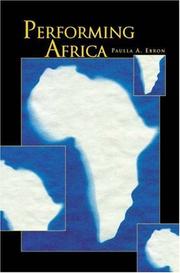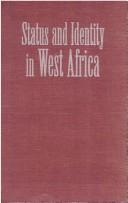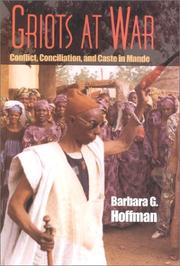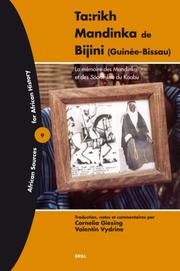| Listing 1 - 10 of 11 | << page >> |
Sort by
|
Book
ISBN: 0993996930 9780993996931 9780993996924 0993996922 9780993996924 Year: 2015 Publisher: Baltimore, Maryland : Baltimore, Md. : Project Muse, Project MUSE,
Abstract | Keywords | Export | Availability | Bookmark
 Loading...
Loading...Choose an application
- Reference Manager
- EndNote
- RefWorks (Direct export to RefWorks)
Manding is a common name for several closely related languages in West Africa: Maninka (or Malinke), Bamana (or Bambara), Jula, Mandinka, Xasonka, etc., spoken by up to 40 million people. In this dictionary, forms of Malian Bamana and Guinean Maninka are included. The polysemy of words is represented in all details, the senses are represented hierarchically. Verbal valencies are indicated throughout and clarified by abundant illustrative examples. Numerous idiomatic expressions are given. Most of lexemes are provided with etymological information: sources of borrowing or proto-forms and their reflexes in other Mande languages. The dictionary is oriented toward advanced language learners and professional linguists, but it can be also useful for native speakers of Bamana and Maninka languages.
Bambara language --- Mandingo language --- Malenke language --- Malinka language --- Malinke language --- Mande language (Mandingo) --- Mandeka language --- Mandenga language --- Manding language --- Mandingue language --- Mandinka language --- Manenka language --- Maninka language --- Mãniyakã language --- Meninka language --- Mandekan languages --- Bamana language (Mandekan) --- Bamanankan language --- English.
Periodical
ISSN: 23795506 Year: 1999 Publisher: Madison, WI : Bloomington, IN : African Studies Program, University of Wisconsin, Indiana University Press
Abstract | Keywords | Export | Availability | Bookmark
 Loading...
Loading...Choose an application
- Reference Manager
- EndNote
- RefWorks (Direct export to RefWorks)
Mandingo (African people) --- Malinke (African people) --- Mandé (African people) --- Manding (African people) --- Mandingue (African people) --- Mandinka (African people) --- Mandino (African people) --- Maninka (African people) --- Maninkaalu (African people) --- Soce (African people) --- Sosse (African people) --- Ethnology --- Social life and customs --- Social life and customs.
Book
ISBN: 9780253351487 0253351480 9780253219848 0253219841 1281958700 0253000416 9786611958701 9780253000415 6611958703 9781281958709 Year: 2008 Publisher: Bloomington [Ind.] Indiana University Press
Abstract | Keywords | Export | Availability | Bookmark
 Loading...
Loading...Choose an application
- Reference Manager
- EndNote
- RefWorks (Direct export to RefWorks)
In A Bird Dance Near Saturday City, Patrick McNaughton carefully considers the components of a bird dance masquerade, its pace, the performers, and what the entire experience means for understandings of Bamana and West African aesthetics and culture.
Folk dancing, Mandingo --- Mandingo (African people) --- Social life and customs. --- Ballo, Sidi. --- Africa, West --- Mandingo folk dancing --- Malinke (African people) --- Mandé (African people) --- Manding (African people) --- Mandingue (African people) --- Mandinka (African people) --- Mandino (African people) --- Maninka (African people) --- Maninkaalu (African people) --- Soce (African people) --- Sosse (African people) --- Ethnology --- Social life and customs

ISBN: 0691074895 0691074887 9786612158544 1282158546 1400825210 9781400825219 9780691074887 9780691074894 Year: 2009 Publisher: Princeton, NJ
Abstract | Keywords | Export | Availability | Bookmark
 Loading...
Loading...Choose an application
- Reference Manager
- EndNote
- RefWorks (Direct export to RefWorks)
The jali--a member of a hereditary group of Mandinka professional performers--is a charismatic but contradictory figure. He is at once the repository of his people's history, the voice of contemporary political authority, the inspiration for African American dreams of an African homeland, and the chief entertainment for the burgeoning transnational tourist industry. Numerous journalists, scholars, politicians, and culture aficionados have tried to pin him down. This book shows how the jali's talents at performance make him a genius at representation--the ideal figure to tell us about the "Africa" that the world imagines, which is always a thing of illusion, magic, and contradiction. Africa often enters the global imagination through news accounts of ethnic war, famine, and despotic political regimes. Those interested in countering such dystopic images--be they cultural nationalists in the African diaspora or connoisseurs of "global culture"--often found their representations of an emancipatory Africa on an enthusiasm for West African popular culture and performance arts. Based on extensive field research in The Gambia and focusing on the figure of the jali, Performing Africa interrogates these representations together with their cultural and political implications. It explores how Africa is produced, circulated, and consumed through performance and how encounters through performance create the place of Africa in the world. Innovative and discerning, Performing Africa is a provocative contribution to debates over cultural nationalism and the construction of identity and history in Africa and elsewhere.
Folklore --- Griots --- Mandingo (African people) --- Music --- Performance --- History and criticism. --- Gambia --- Social life and customs. --- Folk beliefs --- Folk-lore --- Traditions --- Art music --- Art music, Western --- Classical music --- Musical compositions --- Musical works --- Serious music --- Western art music --- Western music (Western countries) --- Malinke (African people) --- Mandé (African people) --- Manding (African people) --- Mandingue (African people) --- Mandinka (African people) --- Mandino (African people) --- Maninka (African people) --- Maninkaalu (African people) --- Soce (African people) --- Sosse (African people) --- Gambie --- Colony of the Gambia --- Republic of the Gambia --- Respublika Gambii︠a︡ --- Gambii︠a︡ --- Gambia, The --- The Gambia --- Ethnology --- Manners and customs --- Material culture --- Mythology --- Oral tradition --- Storytelling --- Historians --- Storytellers --- ガンビア --- Ganbia --- History and criticism --- 冈比亚 --- Gangbiya

ISBN: 1282075640 9786612075643 0253112648 0585231893 9780585231891 0253314097 0253209293 9780253314093 9780253209290 9781282075641 6612075643 9780253112644 Year: 1995 Publisher: Bloomington, Ind. Indiana University Press
Abstract | Keywords | Export | Availability | Bookmark
 Loading...
Loading...Choose an application
- Reference Manager
- EndNote
- RefWorks (Direct export to RefWorks)
Mandingo (African people) --- Artisans --- Social classes --- Social structure --- Endogamy and exogamy --- Regions & Countries - Africa --- History & Archaeology --- Exogamy --- Marriage --- Organization, Social --- Social organization --- Anthropology --- Sociology --- Social institutions --- Class distinction --- Classes, Social --- Rank --- Caste --- Estates (Social orders) --- Social status --- Class consciousness --- Classism --- Social stratification --- Artizans --- Craftsmen --- Craftspeople --- Craftspersons --- Skilled labor --- Cottage industries --- Malinke (African people) --- Mandé (African people) --- Manding (African people) --- Mandingue (African people) --- Mandinka (African people) --- Mandino (African people) --- Maninka (African people) --- Maninkaalu (African people) --- Soce (African people) --- Sosse (African people) --- Ethnology --- Industries. --- Kinship. --- Social life and customs. --- Africa, West --- Industries --- Kinship --- Social life and customs --- Mandingue (Peuple d'Afrique) --- Industrie --- Moeurs et coutumes --- Afrique occidentale

ISBN: 1282062697 9786612062698 0253108934 9780253108937 9781282062696 661206269X 0253338050 9780253338051 Year: 2000 Publisher: Bloomington : Indiana University Press,
Abstract | Keywords | Export | Availability | Bookmark
 Loading...
Loading...Choose an application
- Reference Manager
- EndNote
- RefWorks (Direct export to RefWorks)
In 1985, while she was an apprentice griot or jelimuso, Barbara G. Hoffman saw and recorded a remarkable event that took place in the small town of Kita, Mali. For four days, thousands of griots from all parts of the Mande world gathered together to talk, sing, and make music in celebration of the opening of the new Hall of Griots and the installation of the recently named Head Griot. This unprecedented assembly, unheard of in the history of the Mande, also marked the end of the two-year long 'War of the Griots'; a deadly conflict fought with the tools of the griot verbal masters - words, reputations, and sorcery. "Griots at War" captures griots in action as they made speeches, sang songs of praise, and danced in honor of their renewed unity. Hoffman's discerning transcription and examination of the speeches not only reveals the oratorical skills of griots, but their skill in using history, metaphor, religion, proverbs, and praise to mend a community that had been torn apart by war. But Hoffman discovers a startlingly keen edge to the griots' words. Who intervenes, and how, when war breaks out in the griot community? The speeches made at Kita expose both griots and nobles engaged in behaviours that were strikingly unexpected of people of their status. Hoffman shows that griot public oratory also functions to delineate the boundaries of griot castes and to persuade other castes to recognise and respect what gives each caste its unique identity. While the verbal art of griots has been well documented in the form of epic poetry, "Griots at War" brings their formidable linguistic abilities to the fore as they negotiate, reestablish, and assert their cultural power. This exceptional book offers surprising and important insights into the multiple meanings of Mande culture, caste, and identity.
Oratory --- Oral tradition --- Storytelling --- Griots --- Mandingo (African people) --- Story-telling --- Telling of stories --- Oral interpretation --- Children's stories --- Folklore --- Oral interpretation of fiction --- Tradition, Oral --- Oral communication --- Oral history --- Argumentation --- Oratory, Primitive --- Speaking --- Language and languages --- Rhetoric --- Speeches, addresses, etc. --- Debates and debating --- Elocution --- Eloquence --- Lectures and lecturing --- Persuasion (Rhetoric) --- Public speaking --- Malinke (African people) --- Mandé (African people) --- Manding (African people) --- Mandingue (African people) --- Mandinka (African people) --- Mandino (African people) --- Maninka (African people) --- Maninkaalu (African people) --- Soce (African people) --- Sosse (African people) --- Ethnology --- Historians --- Storytellers --- Kita. --- Social life and customs. --- Performance --- Kita (Kayes, Mali) --- Kita (Mali) --- Kita, Mali --- Folklore.
Book
ISBN: 9004341684 9004325948 Year: 2017 Publisher: Leiden ; Boston : Brill,
Abstract | Keywords | Export | Availability | Bookmark
 Loading...
Loading...Choose an application
- Reference Manager
- EndNote
- RefWorks (Direct export to RefWorks)
Edition d'un récit en mandinka par Maalaŋ Galisa (octobre 1988) sur la constitution et les conditions de vie au Kaabu, territoire situé entre la Gambie, le Sénégal et la Guinée-Bissau, connu depuis le 16e siècle et détruit vers 1867. La gamme des sujets couvre: le peuplement, le gouvernement, les codes de conduite des guerriers, religieux, esclaves et 'hôtes étrangers', les règles de l'esclavage, du mariage et de la succession, la coexistence des religions, les relations entre groupes d'âge et de genre. Le texte diffère d'autres qui se focalisent sur un unique fondateur-patriarche, Tiramakan de l'épopée de Sunjata. Galisa parle du sud-est du Kaabu, à la frontière avec la Guinée. Il ajoute des couleurs locales au modèle mandinka, évoquant la puissance féminine et certains conflits violents. Edition of a recital in Mandinka by Maalaŋ Galisa (October 1988) on the political constitution and living conditions in Kaabu, a territory situated between present Gambia, Senegal and Guinea-Bissau, known since the 16th century, definitely destroyed in 1867. The narrative presents a range of topics covering governance, codes of conduct of warriors, clerics, slaves and 'strangers', rules of slavery, marriage and succession, the cohabitation of different religions, relations of age and gender. This text is distinctive from others focussing on a single founder-patriarch, Tiramakan of the Epic of Sunjata. Galisa focuses on South-eastern Kaabu, bordering on the region of Labé (Guinea). He adds local colours to the Mandinka model, depicting powerful women and violent conflicts resulting from injustice.
Mandingo (African people) --- Oral tradition --- Oral tradition. --- Tradition, Oral --- Oral communication --- Folklore --- Oral history --- Malinke (African people) --- Mandé (African people) --- Manding (African people) --- Mandingue (African people) --- Mandinka (African people) --- Mandino (African people) --- Maninka (African people) --- Maninkaalu (African people) --- Soce (African people) --- Sosse (African people) --- Ethnology --- History. --- Industries --- Kaabu Empire --- Africa --- Guinea-Bissau. --- Ginia Bisao --- Ginia Bisau --- Ginia Bisau Kyōwakoku --- Giniabisao --- Giniabisau --- Guiné-Bissau --- Guinée-Bissao --- Guinée-Bissau --- Gvinei͡a-Bisau --- Portuguese Guinea --- Republic of Guinea-Bissau --- República da Guiné-Bissau --- République de la Guinée-Bissau --- Gabou (Kingdom) --- Gabu Empire --- Mand�e (African people)

ISSN: 15676951 ISBN: 1281925845 9786611925840 9047420705 9789047420705 9789004147249 9004147241 Year: 2007 Volume: v. 9 Publisher: Leiden Boston Brill
Abstract | Keywords | Export | Availability | Bookmark
 Loading...
Loading...Choose an application
- Reference Manager
- EndNote
- RefWorks (Direct export to RefWorks)
Ce tome présente le Ta:rikh Mandinka, un manuscrit rédigé en Arabe et en Mandinka, originaire du village de Bijini en Guinée-Bissau. Inédit jusqu’à présent, le manuscrit consiste en une compilation structurée et très originale sur le Kaabu, réunissant divers récits et chroniques focalisant les débuts mythiques et la chute de cet « empire » païen au milieu du 19ième siècle. Deux versions du manuscrit et plusieurs interprétations (lectures) du Ta:rikh sont reproduites, transcrites, traduites et analysées en tenant compte de questions philologiques, historiques et anthropologiques. L'analyse regarde la communauté cléricale de Bijini en tant que lieu de transmission de savoirs dans un contexte local et régional. Le point focal du livre est l’importance de la diaspora cléricale des Mandinka et Jaakanka (Jakhanké) dans le processus de la construction de l’histoire de l’ « empire » sòoninkee du Kaabu en Sénégambie. Le tome contient un glossaire des noms et des termes mentionnés par les sources, des illustrations, des tableaux, des cartes et des photographies. This volume presents a hitherto unpublished manuscript written in Arabic and Mandinka from the Muslim village of Bijini in Guinea-Bissau, the Ta:rikh Mandinka, a unique and structured compilation unfolding the pagan 'empire' of Kaabu from its mythical beginnings to its downfall in the nineteenth century. Two existing manuscript versions and several oral interpretations of the Ta:rikh are reproduced, transcribed, translated, compared and analysed considering philological, historical and social-anthropological issues (chaps. 1-3). The fourth chapter deals with the clerical community of Bijini as a place of knowledge-transfer in its local setting and within regional networks. The focus of the book is on the importance of the Mandinka and Jakhanka clerical diaspora in the making of the history of the Sooninkee 'empire' of Kaabu in Senegambia. The volume contains a glossary of names and terms mentioned in the sources and is illustrated with maps, photographs and drawings.
Mandingo (African people) --- Soninke (African people) --- Aswanik (African people) --- Dyakanke (African people) --- Gadyaga (African people) --- Marka (West African people) --- Saracole (African people) --- Sarakole (African people) --- Sarawule (African people) --- Serahuli (African people) --- Silabe (African people) --- Toubakai (African people) --- Wakore (African people) --- Ethnology --- Malinke (African people) --- Mandé (African people) --- Manding (African people) --- Mandingue (African people) --- Mandinka (African people) --- Mandino (African people) --- Maninka (African people) --- Maninkaalu (African people) --- Soce (African people) --- Sosse (African people) --- History. --- Social life and customs. --- Bijine (Guinea-Bissau) --- Kaabu Empire --- Gabou (Kingdom) --- Gabu Empire --- Bijini (Guinea-Bissau) --- Mandingo (African people) - Guinea-Bissau - Bijine - History. --- Mandingo (African people) - Guinea-Bissau - Bijine - Social life and customs. --- Soninke (African people) - Guinea-Bissau - Bijine - History. --- Soninke (African people) - Guinea-Bissau - Bijine - Social life and customs. --- Kaabu Empire - History. --- Bijine (Guinea-Bissau) - History. --- Bijine (Guinea-Bissau) - Social life and customs.

ISBN: 0520216873 0520222334 9786612355042 0520924479 128235504X 058528895X 9780520924475 9780585288956 9780520216877 9780520222335 Year: 1999 Publisher: Berkeley University of California Press
Abstract | Keywords | Export | Availability | Bookmark
 Loading...
Loading...Choose an application
- Reference Manager
- EndNote
- RefWorks (Direct export to RefWorks)
Shady Practices is a revealing analysis of the gendered political ecology brought about by conflicting local interests and changing developmental initiatives in a West African village. Between 1975 and 1985, while much of Africa suffered devastating drought conditions, Gambian women farmers succeeded in establishing hundreds of lucrative communal market gardens. In less than a decade, the women's incomes began outstripping their husbands' in many areas, until a shift in development policy away from gender equity and toward environmental concerns threatened to do away with the social and economic gains of the garden boom. Male landholders joined forestry personnel in attempts to displace the gardens and capture women's labor for the irrigation of male-controlled tree crops.This carefully documented microhistory draws on field experience spanning more than two decades and the insights of disciplines ranging from critical human geography to development studies. Schroeder combines the "success story" of the market gardens with a cautionary tale about the aggressive pursuit of natural resource management objectives, however well intentioned. He shows that questions of power and social justice at the community level need to enter the debates of policymakers and specialists in environment and development planning.
Gambia. --- Mandingo (African people)-- Agriculture. --- Patriarchy. --- Mandingo (African people) --- Women, Mandingo --- Agriculture. --- Economic conditions. --- Mandingo women --- Women, Mandingo (African people) --- Malinke (African people) --- Mandé (African people) --- Manding (African people) --- Mandingue (African people) --- Mandinka (African people) --- Mandino (African people) --- Maninka (African people) --- Maninkaalu (African people) --- Soce (African people) --- Sosse (African people) --- Ethnology --- Agroforestry --- Division of labor --- Forest ecology --- Patriarchy --- Sex role --- Gender role --- Sex (Psychology) --- Sex differences (Psychology) --- Social role --- Gender expression --- Sexism --- Androcracy --- Patriarchal families --- Fathers --- Families --- Male domination (Social structure) --- Patrilineal kinship --- Forests and forestry --- Ecology --- Labor, Division of --- Labor --- Economic specialization --- Agro-forestry --- Agriculture --- Tree crops --- Social conditions --- Political aspects --- Economic conditions --- Alkalikunda (Gambia) --- Social life and customs. --- Forest ecosystems --- Gender roles --- Gendered role --- Gendered roles --- Role, Gender --- Role, Gendered --- Role, Sex --- Roles, Gender --- Roles, Gendered --- Roles, Sex --- Sex roles --- 1970s. --- 1980s. --- academic. --- community. --- crops. --- cultural studies. --- drought. --- economics. --- economy. --- environmental. --- environmentalist. --- farmers. --- farming. --- female farmers. --- forestry. --- gambia. --- gardening. --- gender politics. --- gender roles. --- gender studies. --- geography. --- human development. --- irrigation. --- landowners. --- microhistory. --- natural disaster. --- political. --- politics. --- scholarly. --- small town. --- social justice. --- village. --- west africa. --- womens labor. --- working women. --- world history.
Book
ISBN: 9780821419830 0821419838 9780821443972 0821443976 0821419668 Year: 2011 Publisher: Athens Ohio University Press
Abstract | Keywords | Export | Availability | Bookmark
 Loading...
Loading...Choose an application
- Reference Manager
- EndNote
- RefWorks (Direct export to RefWorks)
In Our New Husbands Are Here, Emily Lynn Osborn investigates a central puzzle of power and politics in West African history: Why do women figure frequently in the political narratives of the precolonial period, and then vanish altogether with colonization? Osborn addresses this question by exploring the relationship of the household to the state. By analyzing the history of statecraft in the interior savannas of West Africa (in present-day Guinea-Conakry), Osborn shows that the household, and women within it, played a critical role in the pacifist Islamic state of Kankan-Baté, enabling it to
Mandingo (African people) --- Households --- Women --- Mandingue (Peuple d'Afrique) --- Ménages (Statistique) --- Femmes --- History --- Social conditions --- Histoire --- Conditions sociales --- Samory, --- Kankan (Guinea : Region) --- Guinea --- France --- Kankan (Guinée : Région administrative) --- Guinée --- Colonization --- Social aspects --- Colonies --- Administration. --- Colonisation --- Aspect social --- Administration --- France -- Colonies -- Africa -- Administration. --- Guinea -- Colonization -- Social aspects. --- Households -- Political aspects -- Guinea -- Kankan (Region). --- Kankan (Guinea : Region) -- History. --- Kankan (Guinea : Region) -- Politics and government. --- Mandingo (African people) -- Guinea -- Kankan (Region) -- History. --- Samory, approximately 1830-1900. --- Women -- Guinea -- Kankan (Region) -- Social conditions. --- History & Archaeology --- Regions & Countries - Africa --- Political aspects --- History. --- Social conditions. --- Politics and government. --- Social aspects. --- Ménages (Statistique) --- Kankan (Guinée : Région administrative) --- Guinée --- Human females --- Wimmin --- Woman --- Womon --- Womyn --- Malinke (African people) --- Mandé (African people) --- Manding (African people) --- Mandingue (African people) --- Mandinka (African people) --- Mandino (African people) --- Maninka (African people) --- Maninkaalu (African people) --- Soce (African people) --- Sosse (African people) --- Samodu, --- Samori Touré, --- Samory Touré, --- Touré, Samory, --- Pʻŭrangsŭ --- Frankrig --- Francja --- Frant︠s︡ii︠a︡ --- Prantsusmaa --- Francia (Republic) --- Tsarfat --- Tsorfat --- Franḳraykh --- Frankreich --- Fa-kuo --- Faguo --- Франция --- French Republic --- République française --- Peurancih --- Frankryk --- Franse Republiek --- Francland --- Frencisc Cynewīse --- فرنسا --- Faransā --- Franza --- Republica Franzesa --- Gallia (Republic) --- Hyãsia --- Phransiya --- Fransa --- Fransa Respublikası --- Franse --- Францыя --- Frantsyi︠a︡ --- Французская Рэспубліка --- Frantsuzskai︠a︡ Rėspublika --- Parancis --- Pransya --- Franis --- Francuska --- Republika Francuska --- Bro-C'hall --- Френска република --- Frenska republika --- França --- República Francesa --- Pransiya --- Republikang Pranses --- Γαλλία --- Gallia --- Γαλλική Δημοκρατία --- Gallikē Dēmokratia --- فرانسه --- Farānsah --- צרפת --- רפובליקה הצרפתית --- Republiḳah ha-Tsarfatit --- פראנקרייך --- 法国 --- 法蘭西共和國 --- Falanxi Gongheguo --- フランス --- Furansu --- フランス共和国 --- Furansu Kyōwakoku --- Francija --- République de Guinée --- Gvineĭskai︠a︡ Respublika --- Gvinei︠a︡ --- République populaire révolutionnaire de Guinée --- Republic of Guinea --- Gvineja --- Ranska --- Frankrike --- Females --- Human beings --- Femininity --- Population --- Families --- Home economics --- Ethnology --- France (Provisional government, 1944-1946) --- ギニア --- Ginia --- Гвинея --- French Guinea --- 프랑스 --- Falanxi --- Fa-lan-hsi --- 法蘭西 --- Frankrijk --- Frant︠s︡ --- Франц --- Frant︠s︡ Uls --- Франц Улс
| Listing 1 - 10 of 11 | << page >> |
Sort by
|

 Search
Search Feedback
Feedback About UniCat
About UniCat  Help
Help News
News